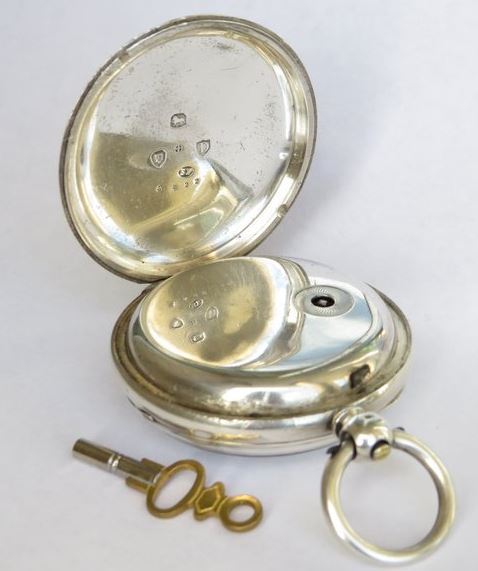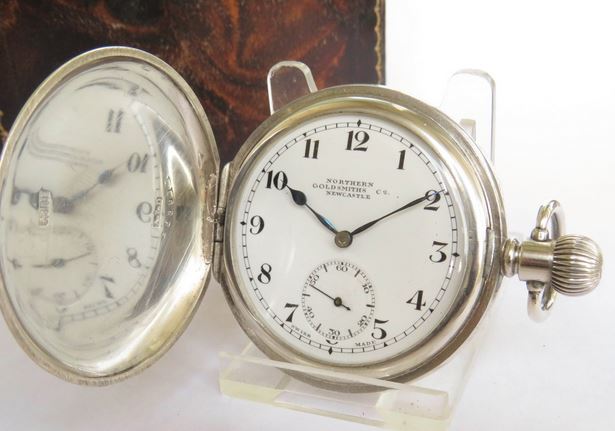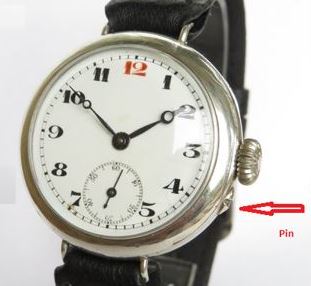Last updated on July 2, 2024
Keyless watches are a relatively recent invention. The earliest watches were wound and set by using a key. Typically, the case back would be opened by depressing the crown which would expose a hole in the inner case back. The watch would be wound by inserting the key into the hole onto the square end of the fusee or barrel arbor. Turning the key would then wind the mainspring, storing power for the watch. The time would generally be set from the front of the watch. The bezel would be opened and the key inserted onto the square boss of the watch hands. Turning the key moves both the minute and the hour hands to set the desired time.
There are several disadvantages to using a key to wind and set a pocket watch. First, the key can get lost. There is no guarantee that someone else’s key will fit your watch as the keys come in different sizes. Second, the hole in the inner case back will be exposed every time the watch is wound. This is likely to be daily. This permits tiny particles of dust into the movement. This will accumulate over time, mixing with the lubricant and clogging the movement. Therefore, key wound and set watches are likely to require more frequent serving. Finally, when setting the time, it is possible to damage the dial or bend the hands. Keyless watches avoid all of these issues.

Keyless watches
Keyless watches have a crown on the end of the pendant at the side of the case. The crown is used to turn a shaft called a stem. The stem links to a mechanism inside the watch movement, which translates to the turning action of the crown. This allows either the mainspring to be wound or the hands to be set. A set of gears called the keyless work winds the mainspring when the crown is rotated. When the crown is pulled out a short distance the keyless work allows the hands to be turned to set the time. The stem attached to the crown has a gear called the castle wheel, with two rings of teeth that project axially from the ends.
When the stem is pushed in, the outer teeth turn the ratchet wheel on top of the mainspring barrel. This action turns the shaft that the inner end of the mainspring is attached to, winding the mainspring. A spring-loaded click presses against the ratchet teeth, preventing the mainspring from unwinding. When the stem is pulled out, the inner teeth of the castle wheel engage with a gear which turns the minute wheel. When the crown is turned, the friction coupling of the cannon pinion allows the hands to be rotated and the time to be set. Today almost all watches are keyless and it is only antique watches that are key wound so the term keyless is redundant. In Swiss watches, a keyless watch was denoted by the term “Remontoir”.

First commercial design
There were many designs and patents for different keyless mechanisms in the early 19th century. However, the first commercially available keyless mechanism was invented in 1845 by French watchmaker, Adrien Philipp (18-15 – 1894). The same year, Philipp joined Patek & Cie as head watchmaker. By 1851 Philipp had become a full partner and the company name changed to Patek Philipp. The first Patek Phillip stem-wind and stem-set pocket watches were sold during the Great Exhibition in London in 1851. Apparently, the first owners of this new kind of watch were Queen Victoria and Prince Albert.
Pin set and lever set
During the latter half of the 19th century, the railroad industry was expanding globally. Accurate timekeeping became critical as were national standards for timekeeping. One of the issues with the crown-set watches was that there was a risk of inadvertently setting the watch to an erroneous time when winding the watch with the stem. Pin-set and lever-set mechanisms overcame this problem. Pin-set is a mechanism which uses a pin on the side of the case, usually set into a small Olivette near the crown, to engage the hand setting mode. One of these is indicated by the red arrow in the picture. With the pin in its normal position, turning the crown winds the mainspring.
To set the hands, the pin is pressed in (usually with a fingernail, hence the alternative name) and the crown is turned which sets the hands. Lever-set mechanisms work in the same way except the process involves engaging a level which is generally hidden beneath the bezel. It is important to note that pin-set and lever-set watches still wind the mainspring via the crown and require it to set the hands.
In the 19th century pin-set and lever-set watches became popular, because they were harder to set and it was near impossible for the wrong time to be accidentally set. When a difference of one or two minutes could mean the difference between a safe journey and a head-on collision of two trains, these mechanisms became crucial. Stem-set watches were still common during this time but lever-set watches were a railway standard for many years following.
Related content
Railroad Chronometer at Wikipedia.


I have an old pocket watch that has been sitting in a drawer for years. It says Limit on the dial, I believe it belonged to a distant uncle. When I turn the crown I don’t feel any pressure from the spring. The crown just turns freely. What does this mean? Does it need a service?
Hi Will, you can read about Limit as a watch manufacturer here. There is also the antique Limit pocket watch that I have in my collection. It is highly likely that the mainspring is broken. It will need a service and a replacement mainspring to get it working again. There is a list of accredited repairers at the British Horological Institute. Other countries will have similar organisations. Thanks for taking the time to comment, Jason
I have an antique Northern Goldsmiths pocket watch that has passed through the family since around 1920. It looks identical to this model. Thanks for all of the useful information. I had assumed that Northern Goldsmiths had made my antique pocket watch, but clearly, they were just the retailer. Thanks for the info.